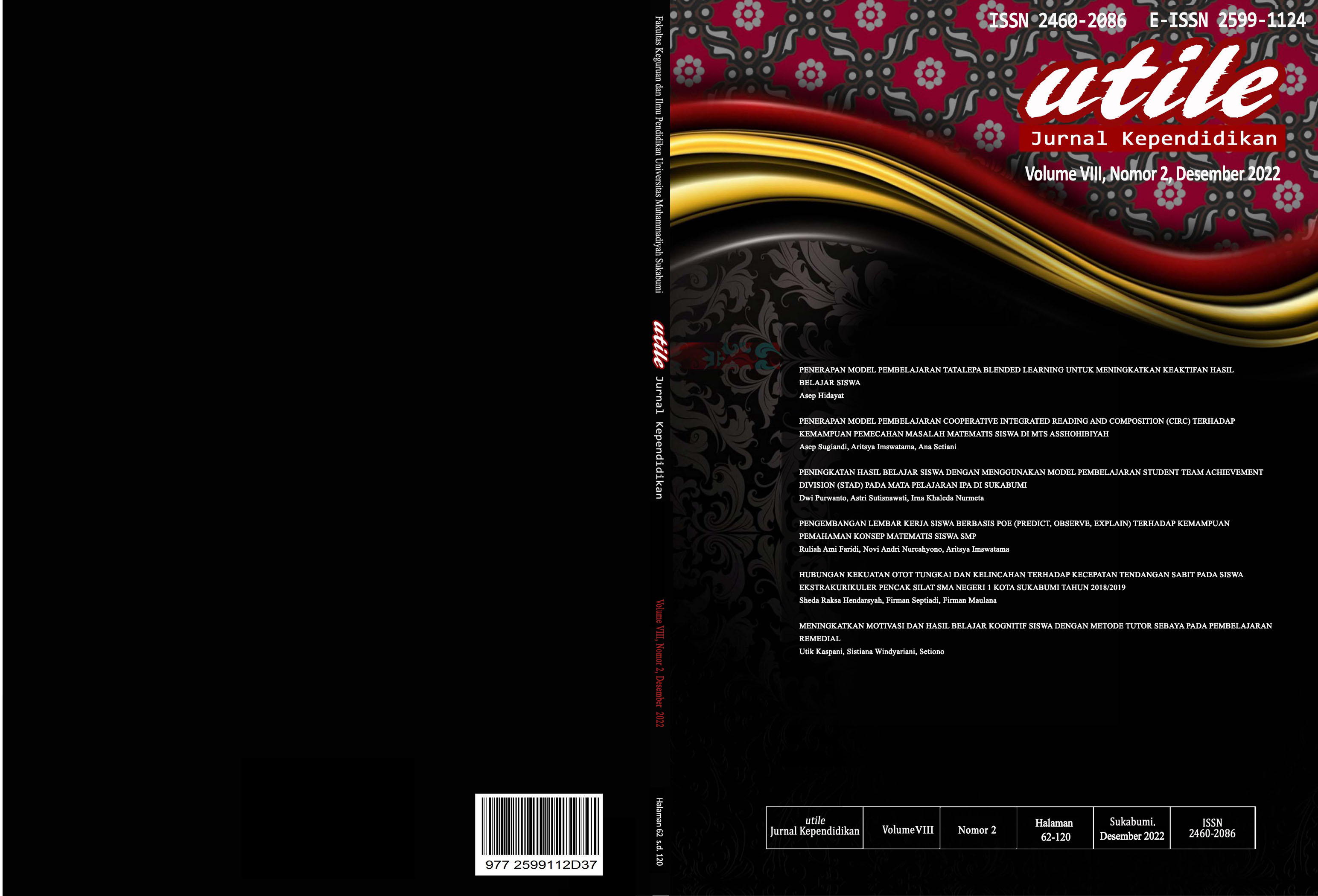Model Pembelajaran Tatalepa Blended Learning di Masa Pandemi Covid-19 untuk Meningkatkan Keaktifan dan Hasil Belajar Siswa
DOI:
https://doi.org/10.37150/jut.v8i2.1653Abstract
Research, entitled " Application of the Tatalepa Blended Learning Model During the Covid-19 Pandemic to Improve Student Activity and Learning Outcomes in ICT Subjects for Class VII Students of SMPN 1 Bojonggenteng " aims to determine the application of the tetalepa blended learning model in SMPN 1 Bojonggenteng and to improve student learning outcomes by implementing this model. This research is a classroom action research, the subject of this research is class VII as many as 30 students. Student learning outcomes are measured using various instruments. Assessment of student knowledge is carried out using multiple choice test questions, assessment of student skills is measured using portfolio assessment, while assessment of attitudes is measured using observation sheets, self-assessment, and peer assessments. The results showed that student learning outcomes had increased, namely in the initial / pre-cycle activities the average student learning outcomes were 71 with a 50% percentage of completeness increased in cycle 1 with an average learning outcomes of 74 but the percentage of completeness was still at 50%. Then in cycle 2 the average student learning outcomes increased to 80 with a percentage of 90% completeness and student activity increased from 41% in cycle 1 to 83% in cycle 2.In conclusion, students can meet the Minimum Completeness Criteria (KKM) of 75 using the model blended learning
References
Dewantari, K., Mustaji, M., & Fatirul, A. N. (2021). Pengaruh Model Pembelajaran Daring Dan Luring Serta Kemampuan Awal Terhadap Hasil Belajar Siswa Pada Mata Pelajaran Tik Smp. JIPI (Jurnal Ilmiah Penelitian Dan Pembelajaran Informatika), 6(2), 219–228. https://doi.org/10.29100/jipi.v6i2.1975
Djamaluddin, A., & Wardana. (2019). Belajar Dan Pembelajaran. In CV Kaaffah Learning Center.
History, A. (2020). Pengembangan Media Pembelajaran Informatika Melalui E-Learning Untuk. 3(3), 330–339. https://doi.org/10.17977/um038v3i32020p330
Lestari, D. D., Ansori, I., & Karyadi, B. (2017). Penerapan Model Pbm Untuk Meningkatkan Kinerja Dan Kemampuan Berpikir Kritis Siswa Sma. Diklabio: Jurnal Pendidikan Dan Pembelajaran Biologi, 1(1), 45–53. https://doi.org/10.33369/diklabio.1.1.45-53
Nurkholis. (2020). Dampak Pandemi Novel-Corona Virus Disiase ( Covid-19 ) Terhadap Psikologi Dan Pendidikan Serta Kebijakan Pemerintah. Pgsd, 6(1), 39–49. https://e-journal.umc.ac.id/index.php/JPS
Chaeruman, U. A., & Maudiarti, S. (2018). Jurnal Pembelajaran Inovatif Quadrant of Blended Learning : a Proposed Conceptual Model for Designing Effective Blended Learning. 1(4), 1–5.
Mendikbud RI. (2020). Surat Edaran Nomor 4 Tahun 2020 Tentang Pelaksanaan Kebijakan Pendidikan Dalam Masa Darurat Penyebaran Coronavirus Disease (COVID-19). 1–3. https://www.kemdikbud.go.id/
Mikhail Gorbachev Dom. (2020). Gaya Hidup Baru Menyongsong New Normal di Masa COVID-19 dan Pengalaman Negara Lain Close-. June, 6–11.
Nurkholis. (2020). Dampak Pandemi Novel-Corona Virus Disiase ( Covid-19 ) Terhadap Psikologi Dan Pendidikan Serta Kebijakan Pemerintah. Pgsd, 6(1), 39–49. https://e-journal.umc.ac.id/index.php/JPS
Pujilestari, Y. (2020). Dampak Positif Pembelajaran Online Dalam Sistem Pendidikan Indonesia Pasca Pandemi Covid-19. Adalah, 4(1), 49–56. http://journal.uinjkt.ac.id/index.php/adalah/article/view/15394/7199
Sugiyono, 2009, Metode Penelitian Kuantitatif, Kualitatif dan R&D, Bandung : Alfabeta.
Syahrin, S. A. (2015). Pengaruh Model Pembelajaran Blended Learning Terhadap Hasil Belajar.
WHO. (2020). Materi Komunikasi Risiko COVID-19 untuk Fasilitas Pelayanan Kesehatan.
Widoyoko, Eko Putro. (2014). Teknik Penyusunan Instrumen Penelitian.Yogyakarta : Pustaka Pelajar







